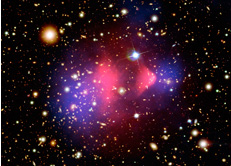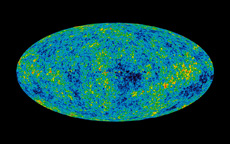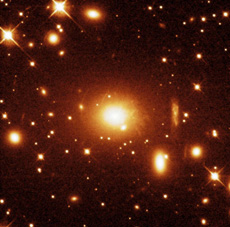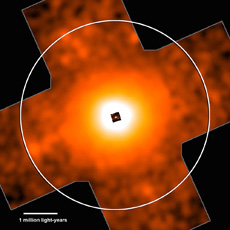Q. What kind of celestial object is a galaxy cluster?
 A colliding galaxy cluster 1E 0657-56. Red shows the distribution of high-temperature gas observed with X-rays, and blue indicates the distribution of dark matter, detected by the gravitational lensing effect. (courtesy: X-ray: NASA/CXC/CfA/M.Markevitch et al.; Optical: NASA/STScI; Magellan/U.Arizona/D.Clowe et al.; Lensing Map: NASA/STScI; ESO WFI; Magellan/U.Arizona/D.Clowe et al.)
A colliding galaxy cluster 1E 0657-56. Red shows the distribution of high-temperature gas observed with X-rays, and blue indicates the distribution of dark matter, detected by the gravitational lensing effect. (courtesy: X-ray: NASA/CXC/CfA/M.Markevitch et al.; Optical: NASA/STScI; Magellan/U.Arizona/D.Clowe et al.; Lensing Map: NASA/STScI; ESO WFI; Magellan/U.Arizona/D.Clowe et al.)
Schematic drawing of the gravitational lensing effect. Due to the gravitational pull of dark matter in a galaxy cluster, the trajectory of light from a galaxy behind that cluster is bent, giving rise to multiple images of the same galaxy. By finding out how much light is affected, we can measure the distribution of dark matter. (courtesy: NASA/CXC/M.Weiss)
A galaxy is a collection of many stars, and a galaxy cluster is made up of anywhere from tens to thousands of galaxies. A galaxy cluster is the largest object in the universe, and by studying how these clusters are distributed and how they evolve, we can find clues to the mystery of the evolution of the entire universe.
Note that a galaxy cluster is not just a collection of galaxies. In reality, all of the galaxies in it together comprise only a few percent of its total mass. Of the remaining mass, about 15 percent is high-temperature gas at more than 10 million degrees Kelvin, and another 80 percent is dark matter.
Q. What is dark matter?
Dark matter is an unknown substance whose mass and gravity influence its surrounding area, but that doesn’t emit any kind of electromagnetic waves such as optical light or X-rays. There are many theories about dark matter, but currently its true identity remains uncertain.
Q. How do we know about the existence of dark matter?
You cannot directly detect dark matter with electromagnetic waves, but there are at least three evidences that support the gravitational effects of dark matter in a galaxy cluster.
First of all, galaxies within a cluster are not still; rather they are moving at speeds ranging from several hundred to more than 1,000 kilometers per second.
Observations reveal that these movements are influenced strongly by the gravity of dark matter. This is almost the same principle as the fact that the speed of the Earth’s orbital movement is affected by the gravity of the Sun.
Second is the presence of high-temperature gas, which I mentioned before. If dark matter didn’t exist, high-temperature gas would diffuse out of the galaxy cluster and vanish. Instead, the gas stays inside the cluster. So we understand that it’s held there by the gravitational pull of dark matter.
The third evidence is a phenomenon called gravitational lensing effect. This is a phenomenon in which the light of celestial objects coming from the other side of a galaxy cluster curves, as if it is passing through a lens. This effect is also attributed to the gravity of dark matter.



